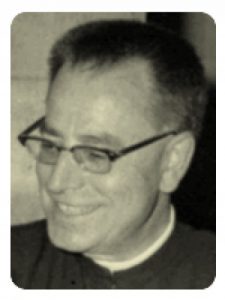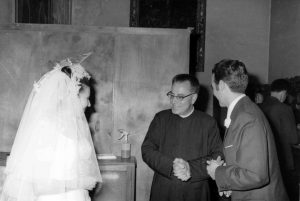
The scientific journey in the life of Dr. Via
Lluís Via Boada was born in Vilafranca del Penedès on October 23, 1910. The beginning of his concern and dedication to geological science was early from his condition as a student of the illustrious paleontologist and stratigraphy Josep Ramon Bataller y Calatayud, an academic of the Royal Academy of Sciences and Arts of Barcelona. This led him to explore a number of fossil deposits. The result of these explorations was the collection of almost all the fossils that are still found today in the Geology section of the Regional Museum of Vilafranca and also at the beginning of his studies on fossil decapods that he would not abandon throughout his entire scientific career. Guided by Van Straelen, director of the Musée Royal de Historia Natural de Belgique, he published his first work on «Els crancs fòssils del Terciari de Catalunya» in 1932.
The circumstances of his ministerial life took him away from science on many occasions. However, forced exile in France during the Spanish Civil War allowed him to attend Geology classes at the University of Angers and was the occasion for him to resume his contact with the study of fossil decapods. The result materialized with the publication in 1941 of an extensive work entitled «Los cangrejos fósiles de Cataluña» in the Bulletin of the Geological and Mining Institute of Spain.
But it was not really until 1946 that he definitively resumed his dedication to science, starting his degree in Natural Sciences which ended in 1951. Professor of Sciences at the Barcelona Council Seminary (1951) and Acting Assistant (1952), then numerary (1960), from the University of Barcelona, began his teaching career that lasted practically his entire life at the Barcelona Seminary and at the Barcelona Faculty of Theology. As of 1979, he left teaching at the University of Barcelona to dedicate himself fully to the Geological Museum of the Conciliar Seminary of Barcelona, where he was director since 1963.
Parallel to his teaching career, he began his research career, which he did within the Spanish Council for Scientific Research (CSIC) from the position of Assistant (1955) of the Paleontology section at the Lucas Mallada Institute to that of Research Professor (1971) of the Patronato Alfonso el Sabio (after the Jaume Almera Institute), a condition that he maintained until his retirement. Within this institution he founded and directed the Section of Biostratigraphy based in the Geological Museum of the Seminary of Barcelona.
The fundamental lines of the research work of Dr. Via
If we want to characterize Dr. Via’s research curriculum in a global way, we must speak above all about the continuity of his fundamental work theme, the rigor of his method and the seriousness of his results. His career as a carcinologist began as we have already said in the 30s and has reached the 90s. His voluminous doctoral thesis (1959), the result of long years of research that, due to various and adverse circumstances, was not published until after 10 years of being defended and many other works on fossil decapods, attracted international attention to her personality that often manifested itself in very concrete things. Thus he collaborated on volume R2 (Crustaceans) of the magnum opus of invertebrate paleontology, the “Treatise on Invertebrate Paleontology”, at the express invitation of R. M. Moore editor of the monumental work. In 1972 he was required to serve on the tribunal that was to judge R. J. F. Jenkins’ thesis “Australian fossil decapod Crustacea” at the distant Australian University of Adelaide. In 1979 he was elected vice president of the GEREM (Groupe Européen de Recherche sur l’Evolution des Malacostracés) in the first Bureau formed as a result of its foundation.
His dedication to the carcinogenic fauna of the Paleogene made him reach biostratigraphic and paleobiogeographic conclusions that he published several times. Many of its conclusions have been confirmed by later investigations based on other faunas, such as that of the nummulitid, especially in the circumpyrenean Eocene.
The discovery of the exceptional Triassic site of Mont-ral (Tarragona), where crustaceans of considerable value are also found, as well as other fauna, occupies his attention very particularly, giving rise to publications of great interest.
Many other fields of paleontology and stratigraphy occupied his time. Many of these works were prompted by the entry of materials into the Geological Museum of the Seminary of Barcelona. The history of this museum on the occasion of the celebration of the Centenary of its foundation (1974) led him to write pages of great interest about this institution and to continue his contributions to the theory and history of Paleontology (see bibliography).
Dr. Via and the Geological Museum of the Seminary of Barcelona
Despite the inestimable value of the research work carried out by Dr. Via, his main work has been the direction of the Geological Museum of the Seminary of Barcelona for many years. This direction was a positive change from the already highly commendable work done by his predecessor and teacher Dr. Bataller. The human conditions of Dr. Via himself and, also, those of the time allowed a considerable enrichment of the museum in several aspects.
The museum premises have more than doubled in space, being able to accommodate an extraordinary increase in paleontological material obtained in scientific campaigns and through donations of private collections of indisputable value. In recent years, the close and fruitful collaboration with the Geological Service of the Generalitat of Catalonia has also meant an expansion of both space and accumulated materials. The number of fossil specimens has more than tripled during these years.
An important aspect of Dr. Via’s work as director of the museum has been the seriousness and scrupulous care that has been taken in registering and locating the fossil forms in cabinets and display cases. Most notably, the placement in a special showcase of the more than 200 holotypes in the museum. Similarly, the increase in the bibliographic collection and the perfect arrangement of the same has contributed to making work in the museum easier, a circumstance that innumerable Spanish and foreign researchers have taken advantage of for the mutual benefit of the museum and the researchers themselves.
Finally, attention can be paid to two aspects of the museum that have been the center of attention and meritorious as a result of the deep dedication of Dr. Via in the Geological Museum of the Seminary. On the one hand, Dr. Via created a system of pedagogically displaying the museum’s own paleontological materials and, through them, it is possible to learn the lesson of the history of life narrated by fossils, a lesson that is used by considerable amounts of high school students in Barcelona. On the other hand, the trust deserved by his tenacious work of collecting and storing geological materials by his colleagues has resulted in the accumulation of an incipient, but remarkable, archive of letters and historical documents of several Catalan geologists already transferred. We can mention those of Dr. Solé Sabarís and that of Dr. Faura y Sans, among others.
Dr. Lluís Via Boada died on November 14, 1991 in the city of Barcelona.
Bibliography
List of publications in the Royal Academy of Sciences and Arts of Barcelona
- «Merostomats fòssils de la Península Ibèrica», Mem. R.A.C.A., XLVIII, 2, 1987 (Admission report).
- Necrologia Dr. M. Crusafont. Nòmina 1983-84, pp. 93-115.
- Discurs de resposta a la memòria d’ingrés del Dr. S. Reguant, Mem. R.A.C.A., L, 15, pp. 41-50, 1991.
Acknowledgements
This biographical note draws on its entirety, with very few amendments, from the obituary published in the RACAB Anuari, 1992-93, p. 97, entitled “NECROLÒGICA DE L’EXCM. MR. DR. Lluís Via Boada” written by Salvador Reguant.

